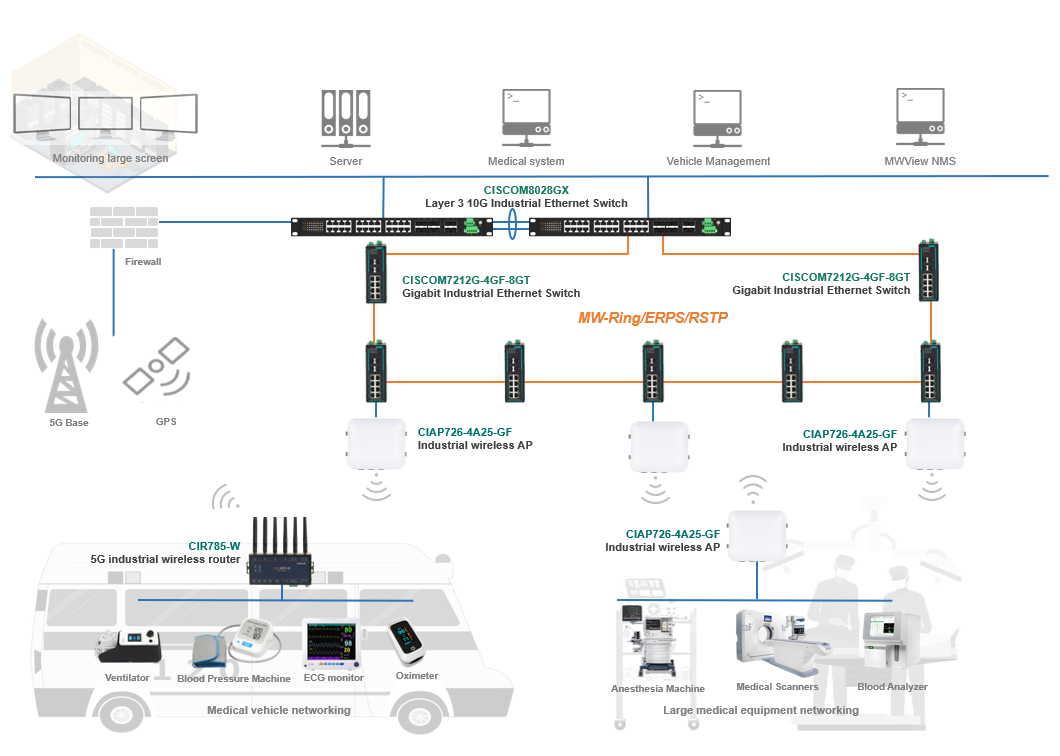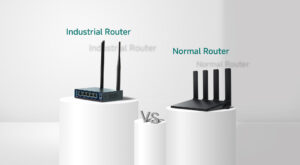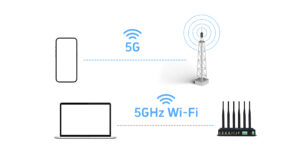In today’s emergency medical response, speed isn’t the only thing that saves lives—real-time communication does too. That’s why modern ambulances are evolving into mobile care units, filled with advanced devices that rely on always-on internet access. Patient monitors, tablets, DVRs, and GPS systems all need to stay online and in sync with hospitals, especially during critical moments on the road.
But staying connected isn’t always easy—especially in rural areas, forests, or remote regions where signal strength drops. That’s where the 5G connected ambulance comes in, and at the heart of it lies one key component: the 5G industrial router.
How Does a 5G Router Work Inside a Connected Ambulance?
A 5G router inside the ambulance functions as the central gateway for every device on board. Installed securely within the vehicle, it connects to available 5G cellular networks and distributes internet access through both Ethernet ports and Wi-Fi.
When an ambulance is in motion—moving between urban areas and weak-signal zones—the router keeps evaluating which mobile network offers the best connection. Advanced models support dual SIM cards, automatically switching to the stronger network when needed. This ensures that no matter the location, the connection remains uninterrupted.
Wired equipment like DVR systems, patient monitors, and onboard computers connect directly to the router’s Ethernet ports. This guarantees high throughput and low latency, perfect for transmitting large video files or real-time medical data to hospitals.
Meanwhile, devices like tablets, diagnostic tools, and wireless sensors use the router’s Wi-Fi. Paramedics can freely move around inside the ambulance without losing access to medical systems or cloud-based tools. This wireless freedom becomes especially useful during treatment in motion or patient handovers.

To handle all this traffic smoothly, the router must manage data efficiently. When multiple devices are sending and receiving data at once, intelligent load balancing ensures that bandwidth is allocated properly—so everything from live ECG streaming to camera feeds works without buffering or dropouts.
Data Security on the Move
In emergency medical care, data privacy and protection are non-negotiable. The 5G router doesn’t just keep devices online—it ensures secure transmission of sensitive patient data.
Built-in VPN protocols like IPSec, OpenVPN, and L2TP create encrypted communication tunnels between the ambulance and the hospital or cloud servers. This makes it possible to transmit patient reports, video calls, or telemetry data without worrying about data leaks or unauthorized access.
Rugged and Built for the Road
Ambulances operate under tough conditions—bumpy roads, constant movement, fluctuating temperatures. That’s why the router must be designed for industrial use. A reliable 5G router offers rugged features like shock resistance, wide temperature tolerance, and ignition-controlled boot-up.
These are not off-the-shelf consumer routers. They are built specifically for transportation environments where downtime is not an option.
How to Choose the Right 5G Router for a Connected Ambulance
Choosing the right 5G router for emergency vehicles isn’t just about speed—it’s about resilience, flexibility, and security. Here are the key features to look for:
1. Dual SIM with Automatic Failover
Ensures seamless network switching to maintain real-time connectivity, even in remote areas.
2. Load Balancing
Optimizes bandwidth for simultaneous use of patient monitors, GPS, video systems, and cloud access.
3. Gigabit Ethernet + Wi-Fi
Offers wired and wireless flexibility. Mission-critical equipment can use Ethernet, while tablets and mobile tools stay connected via Wi-Fi.
4. VPN Support
Secures patient data with encrypted connections between the ambulance and medical centers.
5. Industrial-Grade Design
Withstands vibration, temperature changes, and power fluctuations typical of mobile environments.
💡 If you’re looking for a reliable, vehicle-grade solution, explore our selection of 5G industrial routers for mobile and emergency use. These models are built to support real-time care in connected ambulances, offering features like dual SIM failover, industrial Wi-Fi, and encrypted communication.
Conclusion: 5G Routers Are the Backbone of Connected Ambulance
The 5G connected ambulance is a powerful step forward in emergency healthcare. But none of its advanced features would work without the communication infrastructure provided by the router. It connects the patient to the hospital, the camera to the command center, and the paramedic to real-time data—no matter where the vehicle is.
By choosing the right 5G router designed for emergency response vehicles, you’re not just buying a piece of hardware—you’re building a life-saving digital link. One that ensures every second counts, and nothing important gets lost in transit.


